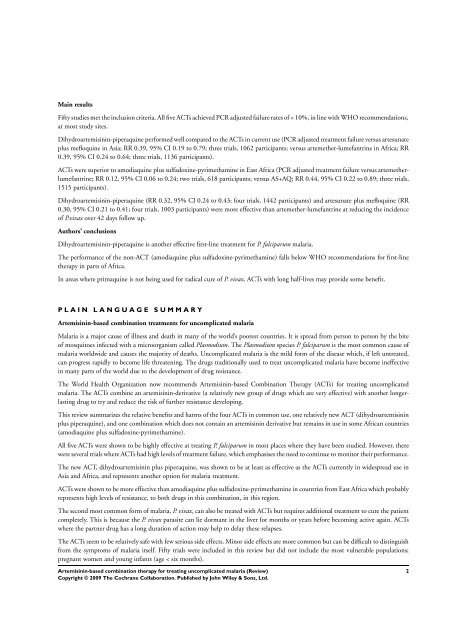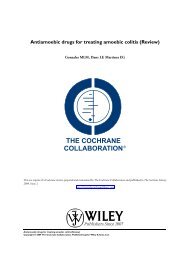Artemisinin-based combination therapy for ... - The Cochrane Library
Artemisinin-based combination therapy for ... - The Cochrane Library
Artemisinin-based combination therapy for ... - The Cochrane Library
Create successful ePaper yourself
Turn your PDF publications into a flip-book with our unique Google optimized e-Paper software.
Main results<br />
Fifty studies met the inclusion criteria. All five ACTs achieved PCR adjusted failure rates of < 10%, in line with WHO recommendations,<br />
at most study sites.<br />
Dihydroartemisinin-piperaquine per<strong>for</strong>med well compared to the ACTs in current use (PCR adjusted treatment failure versus artesunate<br />
plus mefloquine in Asia; RR 0.39, 95% CI 0.19 to 0.79; three trials, 1062 participants; versus artemether-lumefantrine in Africa; RR<br />
0.39, 95% CI 0.24 to 0.64; three trials, 1136 participants).<br />
ACTs were superior to amodiaquine plus sulfadoxine-pyrimethamine in East Africa (PCR adjusted treatment failure versus artemetherlumefantrine;<br />
RR 0.12, 95% CI 0.06 to 0.24; two trials, 618 participants; versus AS+AQ; RR 0.44, 95% CI 0.22 to 0.89; three trials,<br />
1515 participants).<br />
Dihydroartemisinin-piperaquine (RR 0.32, 95% CI 0.24 to 0.43; four trials, 1442 participants) and artesunate plus mefloquine (RR<br />
0.30, 95% CI 0.21 to 0.41; four trials, 1003 participants) were more effective than artemether-lumefantrine at reducing the incidence<br />
of P.vivax over 42 days follow up.<br />
Authors’ conclusions<br />
Dihydroartemisinin-piperaquine is another effective first-line treatment <strong>for</strong> P. falciparum malaria.<br />
<strong>The</strong> per<strong>for</strong>mance of the non-ACT (amodiaquine plus sulfadoxine-pyrimethamine) falls below WHO recommendations <strong>for</strong> first-line<br />
<strong>therapy</strong> in parts of Africa.<br />
In areas where primaquine is not being used <strong>for</strong> radical cure of P. vivax, ACTs with long half-lives may provide some benefit.<br />
P L A I N L A N G U A G E S U M M A R Y<br />
<strong>Artemisinin</strong>-<strong>based</strong> <strong>combination</strong> treatments <strong>for</strong> uncomplicated malaria<br />
Malaria is a major cause of illness and death in many of the world’s poorest countries. It is spread from person to person by the bite<br />
of mosquitoes infected with a microorganism called Plasmodium. <strong>The</strong> Plasmodium species P. falciparum is the most common cause of<br />
malaria worldwide and causes the majority of deaths. Uncomplicated malaria is the mild <strong>for</strong>m of the disease which, if left untreated,<br />
can progress rapidly to become life threatening. <strong>The</strong> drugs traditionally used to treat uncomplicated malaria have become ineffective<br />
in many parts of the world due to the development of drug resistance.<br />
<strong>The</strong> World Health Organization now recommends <strong>Artemisinin</strong>-<strong>based</strong> Combination <strong>The</strong>rapy (ACTs) <strong>for</strong> treating uncomplicated<br />
malaria. <strong>The</strong> ACTs combine an artemisinin-derivative (a relatively new group of drugs which are very effective) with another longerlasting<br />
drug to try and reduce the risk of further resistance developing.<br />
This review summarizes the relative benefits and harms of the four ACTs in common use, one relatively new ACT (dihydroartemisinin<br />
plus piperaquine), and one <strong>combination</strong> which does not contain an artemisinin derivative but remains in use in some African countries<br />
(amodiaquine plus sulfadoxine-pyrimethamine).<br />
All five ACTs were shown to be highly effective at treating P. falciparum in most places where they have been studied. However, there<br />
were several trials where ACTs had high levels of treatment failure, which emphasises the need to continue to monitor their per<strong>for</strong>mance.<br />
<strong>The</strong> new ACT, dihydroartemisinin plus piperaquine, was shown to be at least as effective as the ACTs currently in widespread use in<br />
Asia and Africa, and represents another option <strong>for</strong> malaria treatment.<br />
ACTs were shown to be more effective than amodiaquine plus sulfadoxine-pyrimethamine in countries from East Africa which probably<br />
represents high levels of resistance, to both drugs in this <strong>combination</strong>, in this region.<br />
<strong>The</strong> second most common <strong>for</strong>m of malaria, P. vivax, can also be treated with ACTs but requires additional treatment to cure the patient<br />
completely. This is because the P. vivax parasite can lie dormant in the liver <strong>for</strong> months or years be<strong>for</strong>e becoming active again. ACTs<br />
where the partner drug has a long duration of action may help to delay these relapses.<br />
<strong>The</strong> ACTs seem to be relatively safe with few serious side effects. Minor side effects are more common but can be difficult to distinguish<br />
from the symptoms of malaria itself. Fifty trials were included in this review but did not include the most vulnerable populations;<br />
pregnant women and young infants (age < six months).<br />
<strong>Artemisinin</strong>-<strong>based</strong> <strong>combination</strong> <strong>therapy</strong> <strong>for</strong> treating uncomplicated malaria (Review)<br />
Copyright © 2009 <strong>The</strong> <strong>Cochrane</strong> Collaboration. Published by John Wiley & Sons, Ltd.<br />
2








